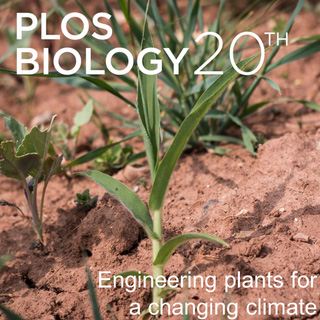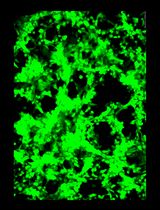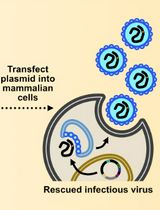- EN - English
- CN - 中文
Development and Application of MLB Human Astrovirus Reverse Genetics Clones and Replicons
MLB人星状病毒逆遗传克隆及复制子的发展与应用
发布: 2025年02月20日第15卷第4期 DOI: 10.21769/BioProtoc.5201 浏览次数: 1126
评审: Jibin SadasivanVamseedhar RayaproluAnonymous reviewer(s)

相关实验方案
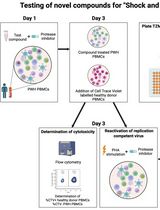
诱导型HIV-1库削减检测(HIVRRA):用于评估外周血单个核细胞中HIV-1潜伏库清除策略毒性与效力的快速敏感方法
Jade Jansen [...] Neeltje A. Kootstra
2025年07月20日 1566 阅读
Abstract
Human astroviruses pose a significant public health threat, especially to children, the elderly, and immunocompromised individuals. Nevertheless, these viruses remain largely understudied, with no approved antivirals or vaccines. This protocol focuses on leveraging reverse genetics (RG) and replicon systems to unravel the biology of MLB genotypes, a key group of neurotropic astroviruses. Using reverse genetics and replicon systems, we identified critical genetic deletions linked to viral attenuation and neurotropism, pushing forward vaccine development. We also uncovered novel replication mechanisms involving ER membrane interactions, opening doors to new antiviral targets. Reverse genetics and replicon systems are essential for advancing our understanding of astrovirus biology, identifying virulence factors, and developing effective treatments and vaccines to combat their growing public health impact.
Key features
• Provides a basic understanding of the molecular biology of MLB astroviruses, aiding in addressing open questions related to virus evolution, replication, and pathogenesis.
• Facilitates the development of novel therapeutics and vaccines.
• Enables rapid testing of antiviral drugs against MLB astroviruses.
Keywords: Human astrovirus (人星状病毒)Graphical overview
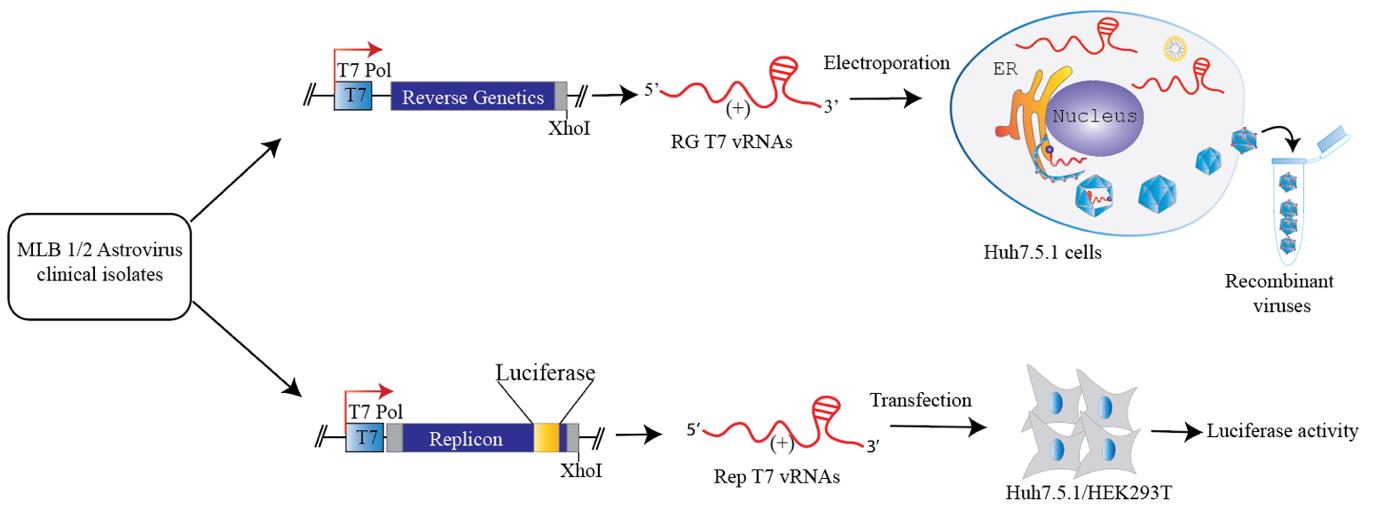
Background
Human astroviruses (HAstVs) are small, positive-sense RNA viruses primarily associated with gastroenteritis, causing symptoms such as diarrhea, vomiting, and abdominal cramps. These viruses significantly impact public health, particularly affecting young children, the elderly, and immunocompromised individuals, accounting for up to 9% of pediatric gastroenteritis cases globally. There are three major groups of human astroviruses: classical HAstVs, newly emerging HAstV-MLB (Melbourne), and HAstV-VA/HMO (Virginia/human-mink-ovine-like) astroviruses. These viruses are globally prevalent, infect a wide range of species, and demonstrate the capacity for rapid evolution and adaptation to different hosts. Despite their medical importance, many human astroviruses remain understudied due to the lack of essential molecular tools, such as reverse genetics (RG) infectious clones and replicon systems. In addition to causing gastrointestinal disease, certain astroviruses, particularly the MLB genogroup, have been implicated in severe neurological complications, such as encephalitis and meningitis. The MLB genogroup includes distinct viral strains: MLB1, MLB2, and MLB3. Among these, MLB1 is the most prevalent genotype, followed by MLB2 and MLB3. All MLB stains share similarities, including genomic organization and neurotropic potential. Recent studies [1] have developed critical molecular biology tools, such as reverse genetics systems, replicon systems, and immunodetection assays, to investigate the key stages of MLB astrovirus infection. Additionally, novel replication mechanisms were recently uncovered using the MLB RG and replicon systems [2]. These findings revealed interactions between endoplasmic reticulum (ER) membranes and replication factories located in close proximity to the nuclear periphery in a nsP1-dependent manner, providing new insights and potential targets for antiviral therapies.
Materials and reagents
Biological materials
1. Huh7.5.1 cells (obtained from Apath, Brooklyn, New York, United States of America)
2. MLB1 RG infectious virus stocks (from this study, store at -70 °C)
3. MLB2 RG infectious virus stocks (from this study, store at -70 °C)
4. MLB1 replicon based on the reverse genetics of MLB1 (from this study, -20 °C)
5. MLB2 replicon based on the reverse genetics of MLB2 (from this study, -20 °C)
Reagents
1. Dulbecco’s modified Eagle’s medium (DMEM) (PAN Biotech, catalog number: P04-03600)
2. Fetal bovine serum (FBS) (PAN Biotech, catalog number: P40-37500)
3. Penicillin-streptomycin (10,000 U/mL) (Life Technologies, catalog number: 15140-122)
4. 200 mM L-Glutamine (Gibco, catalog number: 25030081)
5. Phosphate buffered saline (PBS) (Life Technologies, catalog number: 14190-144)
6. 1 M HEPES buffer, pH range 7.2–7.5 (Life Technologies, catalog number: 15630-080)
7. 0.25% Trypsin-EDTA (Gibco, catalog number: 25200056)
8. Bovine serum albumin (BSA) (PAN Biotech, catalog number: P06-1395500)
9. Direct-zolTM RNA MiniPrep Plus (Zymo Research, catalog number: R2072)
10. PhusionTM Plus DNA polymerase (Thermo Fisher Scientific, catalog number: F630S)
11. XhoI (Thermo Fisher Scientific, catalog number: FD0695)
12. OptiMEM I (Gibco, catalog number: 31985070)
13. RNA Clean-Up and Concentrator kit (Zymo Research, catalog number: R1016)
14. RNaseOUT (Invitrogen, catalog number: 10777019)
15. Paraformaldehyde solution (PFA), 4% in PBS (Thermo Fisher Scientific, catalog number: 30525-89-4)
16. Βeta-mercaptoethanol (Sigma, catalog number: M3148)
17. T7 mMESSAGE mMACHINE Transcription kit (Thermo Fisher Scientific, catalog number: AM1344)
18. T7 Firefly luciferase plasmid (Promega, catalog number: L482A)
19. QIAquick Gel Extraction kit (Qiagen, catalog number: 28704)
20. QIAquick PCR Purification Kit (Qiagen, catalog number: 28104)
21. Dual-Luciferase Reporter Assay System (Promega, catalog number: E1980)
22. Anti-CP antibody (custom-made rabbit polyclonal antibody)
23. Anti-tubulin antibody (Abcam, mouse monoclonal antibody, catalog number: ab6160)
24. IRDye 800 CW goat anti-rabbit secondary antibody (LI-COR Biotechnology, catalog number: 926-32211)
25. IRDye 680 RD goat anti-mouse IgG secondary antibody (LI-COR Biotechnology, catalog number: 926-68070)
26. Anti-dsRNA antibody (anti-dsRNA IgG2a) (Scicons J2, catalog number: 10010500)
27. Goat anti-rabbit IgG (H+L) secondary antibody Alexa 488-conjugated (Thermo Fisher Scientific, catalog number: A-11008)
28. Goat anti-mouse IgG (H+L) secondary antibody 594-conjugated (Thermo Fisher Scientific, catalog number: A-11005)
29. Nitrocellulose membrane, 0.2 μm (Thermo Fisher Scientific, catalog number: 15209874)
30. 8% Sodium azide solution (Thistle Scientific, catalog number: SBL-40-2008-01)
31. MEM non-essential amino acid solution (Sigma, catalog number: M7145)
32. GibcoTM VP-SFM media (Fisher Scientific, catalog number: 10593273)
33. Normal goat serum (Abcam, catalog number: ab7481)
34. DNase I (Zymo Research, catalog number: E1011)
35. Lipofectamine 2000 (Thermo Fisher Scientific, catalog number: 11668019)
36. QIAGEN Plasmid Plus Midi Sample kit (Qiagen, catalog number: 12941)
37. Agarose (Sigma-Aldrich, catalog number: A9539)
38. Tween-20 (Sigma-Aldrich, catalog number: P1379)
39. PIPES (Sigma-Aldrich, catalog number: P6757)
40. EGTA (Sigma-Aldrich, catalog number: 03777)
41. MgCl2 (Sigma-Aldrich, catalog number: 31413)
42. NaOH (Sigma-Aldrich, catalog number: 06203)
43. Glycerol (Sigma-Aldrich, catalog number: G5516)
44. Triton X-100 (Thermo Fisher Scientific, catalog number: HFH10)
45. Tris HCl (Duchefa Biochemie, catalog number: T1513)
46. SDS (Sigma-Aldrich, catalog number: 75746)
47. pAVIC plasmid [3]
48. Bromophenol blue (Sigma-Aldrich, catalog number: B0126)
49. Dried skimmed milk powder (Marvel, multiple suppliers, grocery stores)
50. Formaldehyde, methanol free (Polysciences, catalog number: 04018-1)
51. Hoechst stain (Thermo Fisher Scientific, catalog number: 62249)
52. Wheat germ agglutinin (WGA) (Thermo Fisher Scientific, catalog number: W11261)
53. Perasafe (Medisave, catalog number: UN068)
54. Chemgene (Thermo Fisher Scientific, catalog number: SKU075A)
55. Qiagen AVL lysis buffer (Qiagen, catalog number: 19073)
56. Zymo-Spin IC columns (Zymo Research, catalog number: C1004-50)
57. Invitrogen SuperScript III Reverse Transcriptase (Thermo Fisher Scientific, catalog number: 18080044)
58. RNase-free water (Qiagen, catalog number: 129112)
59. 10% Chloros (sodium hypochlorite) (Thermo Fisher Scientific, catalog number: 219255000)
Solutions
1. Complete media (DMEM-GHAA-10% FBS) (see Recipes)
2. DMEM-GHAA-5% FBS media (see Recipes)
3. Infection media (DMEM-GHAA+0.2% BSA) (see Recipes)
4. DMEM-GH-2% FBS media (see Recipes)
5. DMEM-GH media (see Recipes)
6. Transfection media (15 mL)
7. Serum-free media (DMEM-GHAA) (see Recipes)
8. VPSF-GHAA media (see Recipes)
9. Antibody solution (see Recipes)
10. 2× PHEM buffer (see Recipes)
11. 2× Loading buffer + beta mercaptoethanol (2× LB-βME) (see Recipes)
12. 0.08% Trypsin-EDTA solution (see Recipes)
13. 1% Perasafe solution (see Recipes)
14. 5% Chemgene solution (see Recipes)
15. 0.1% PBST solution (see Recipes)
Recipes
1. Complete media (DMEM-GHAA-10% FBS) (500 mL)
| Reagent | Final concentration | Quantity or Volume |
|---|---|---|
| DMEM | n/a | 429 mL |
| 100% FBS | 10% | 50 mL |
| 1 M HEPES | 20 mM | 10 mL |
| Penicillin and streptomycin | 20 Units/mL | 1 mL |
| 100× MEM non-essential amino acids | n/a | 5 mL |
| 200 mM L-glutamine | 2 mM | 5 mL |
| Total (optional) | n/a | 500 mL |
2. DMEM-GHAA-5% FBS media (500 mL)
| Reagent | Final concentration | Quantity or Volume |
|---|---|---|
| DMEM | n/a | 454 mL |
| 100% FBS | 5% | 25 mL |
| 200 mM L-glutamine | 2 mM | 5 mL |
| 1 M HEPES | 20 mM | 10 mL |
| Penicillin and streptomycin | 20 Units/mL | 1 mL |
| 100× MEM non-essential amino acid | n/a | 5 mL |
| Total (optional) | 500 mL |
3. Infection media (DMEM-GHAA+0.2% BSA) (50 mL)
| Reagent | Final concentration | Quantity or Volume |
|---|---|---|
| DMEM | n/a | 46.9 mL |
| 200 mM L-glutamine | 2 mM | 0.5 mL |
| 1 M HEPES | 20 mM | 1 mL |
| Penicillin and streptomycin | 20 Units/mL | 0.1 mL |
| 100× MEM non-essential amino acid | n/a | 0.5 mL |
| 10% BSA | 0.2% | 1.0 mL |
| Total (optional) | n/a | 50 mL |
4. DMEM-GH-2% FBS media (500 mL)
| Reagent | Final concentration | Quantity or Volume |
|---|---|---|
| DMEM | n/a | 475 mL |
| 100% FBS | 2% | 10 mL |
| 1 M HEPES | 20 mM | 10 mL |
| 200 mM L-glutamine | 2 mM | 5 mL |
| Total (optional) | n/a | 500 mL |
5. DMEM-GH media (500 mL)
| Reagent | Final concentration | Quantity or Volume |
|---|---|---|
| DMEM | n/a | 485 mL |
| 200 mM L-glutamine | 2 mM | 5 mL |
| 1 M HEPES | 20 mM | 10 mL |
| Total (optional) | n/a | 500 mL |
6. Transfection media (15 mL)
| Reagent | Final concentration | Quantity or Volume |
|---|---|---|
| OptiMEM | n/a | 15 mL |
| RNaseOUT | 40 Units/mL | 15 μL |
| Total (optional) | n/a | 15 mL |
7. Serum-free media (DMEM-GHAA) (500 mL)
| Reagent | Final concentration | Quantity or Volume |
|---|---|---|
| DMEM | n/a | 479 mL |
| 1 M HEPES | 20 mM | 10 mL |
| Penicillin and streptomycin | 20 Units/mL | 1 mL |
| 100× MEM non-essential amino acids | n/a | 5 mL |
| 200 mM L-glutamine | 2 mM | 5 mL |
| Total (optional) | n/a | 500 mL |
8. VPSF-GHAA media (50 mL)
| Reagent | Final concentration | Quantity or Volume |
|---|---|---|
| VP-SFM media | n/a | 47.9 mL |
| 1 M HEPES | 20 mM | 1 mL |
| Penicillin and streptomycin | 20 Units/mL | 0.1 mL |
| 100× MEM non-essential amino acids | n/a | 0.5 mL |
| 200 mM L-glutamine | 2 mM | 0.5 mL |
| Total (optional) | n/a | 50 mL |
9. Antibody solution (100 mL)
| Reagent | Final concentration | Quantity or Volume |
|---|---|---|
| PBS | 1× | 100 mL |
| 100% goat serum | 0.5% | 0.5 mL |
| 8% sodium azide | 0.02% | 0.25 mL |
| Total (optional) | n/a | 100 mL |
10. 2× PHEM buffer (500 mL)
| Reagent | Final concentration | Quantity or Volume |
|---|---|---|
| PIPES | 120 mM | 72.56 g |
| HEPES | 50 mM | 23.84 g |
| EGTA | 20 mM | 15.2 g |
| 2 M MgCl2 | 4 mM | 1 mL |
| H2O | n/a | see note* |
| Total (optional) | n/a | 500 mL |
*First dissolve PIPES in 400 mL of water and then add the other reagents. Adjust pH to 7.2 with 5 M NaOH or KOH.
11. 2× loading buffer + beta-mercaptoethanol (2× LB-βME) (10 mL)
| Reagent | Final concentration | Quantity or Volume |
|---|---|---|
| 1 M Tris HCl pH 6.8 | 125 mM | 1.25 mL |
| 10% SDS | 4% | 4 mL |
| 1% Bromophenol blue | 0.04% | 0.4 mL |
| 100% glycerol | 20% | 2 mL |
| Beta-mercaptoethanol | 10% | 1 mL |
Then, add water to make a final volume of 10 mL.
12. 0.08% Trypsin-EDTA solution
Add 2.5 mL of 0.25% trypsin-EDTA in 7.5 mL of PBS.
13. 1% Perasafe solution
1 g of Perasafe powder in 100 mL of water.
14. 5% Chemgene solution
Add 50 mL of Chemgene in 1,000 mL of water.
15. 0.1% PBST solution
Add 1 mL of Tween-20 in 1,000 mL of PBS.
Laboratory supplies
1. Pipette tips (Thermo Fisher Scientific, catalog numbers: 02-707-426, 02-707-403, 02-707-438)
2. 1.5 mL microfuge tubes (STARLAB, catalog number: 51615-5500)
3. 15 mL Falcon tubes (Corning, catalog number: 430052)
4. 50 mL Falcon tubes (Corning, catalog number: 430829)
5. T175 tissue culture flasks (TPP® tissue culture flasks) (Sigma, catalog number: Z707562)
6. 6-multiwell polystyrene culture plates (TPP® tissue culture plates) (Sigma, catalog number: Z707767)
7. 12-multiwell polystyrene culture plates (TPP® tissue culture plates) (Sigma, catalog number: Z707775)
8. IBIDI 8-well chambered slides (Ibidi GmbH, catalog number: 80807-90)
9. 96-well flat-bottom plate (TPP, catalog number: Z707902)
10. U-bottom 96-well plate (TPP, catalog number: Z707899)
11. 0.2 μM filters (Appleton, catalog number: ACF141)
12. Screw-cap tubes (Axigen, catalog number: SCT-150-A-S)
Equipment
1. Biosafety level 2 culture cabinet (Wolflabs, model: BioMAT 2 BM21800R)
2. -70 °C freezer (Eppendorf, catalog number: F660320001)
3. Vortex (Heidolph, model: Reax Top)
4. Spray bottle with 70% ethanol (Sigma-Aldrich, catalog number: 32221)
5. Pipettes: 1,000 μL (StarLab, catalog number: S1111-6001)
6. Pipettes: 200 μL (StarLab, catalog number: S1111-0000)
7. Pipettes: 10 μL (StarLab, catalog number: S1111-3000)
8. Pipettes: 2 μL (StarLab, catalog number: S1111-3000)
9. 25 mL pipettes (Corning, catalog number: 760 180)
10. 10 mL pipettes (Corning, catalog number: 4488)
11. CO2 incubator (PHCBI, catalog number: MCO-230AIC)
12. Hemocytometer (Logos BioSystems, catalog number: L40002)
13. Cell counting slides (Logos BioSystems, catalog number: L12002)
14. Rocking platform shaker (Cole-ParmerTM, catalog number: WZ-51900-30)
15. Phase-contrast inverted microscope (Nikon TMS Inverted Microscope)
16. 4 °C refrigerator (LabCold, catalog number: RLPR0517)
17. Autoclave (BMM Weston, custom-made)
18. Bio-Rad Gene Pulser Xcell system (Bio-Rad, catalog number: 1652661)
19. Electroporation cuvettes (Bio-Rad, catalog number: 1652091)
20. Water bath (Clifton, catalog number: ZT1250337S)
21. LI-COR ODYSSEY CLx imager (LicorBio, catalog number: 9140-09)
22. Leica SP5 confocal microscope (Leica Microsystems, catalog number: Leica DMI6000 CS)
23. Trans-Blot Turbo transfer system (Bio-Rad, catalog number: 1704150EDU)
24. SDS-PAGE running assembly (Bio-Rad, catalog number: 1658001FC)
25. GloMax® Navigator microplate luminometer (Promega, catalog number: GM2010)
26. NanoDropTM 2000 spectrophotometer (Thermo Fisher Scientific, catalog number: ND2000)
Software and datasets
1. ImageJ 1.47v (10.2)
2. Prism v8.2.2 (GraphPad, July 2019)
Procedure
文章信息
稿件历史记录
提交日期: Sep 11, 2024
接收日期: Dec 10, 2024
在线发布日期: Jan 19, 2025
出版日期: Feb 20, 2025
版权信息
© 2025 The Author(s); This is an open access article under the CC BY license (https://creativecommons.org/licenses/by/4.0/).
如何引用
Ali, H., Noyvert, D. and Lulla, V. (2025). Development and Application of MLB Human Astrovirus Reverse Genetics Clones and Replicons. Bio-protocol 15(4): e5201. DOI: 10.21769/BioProtoc.5201.
分类
微生物学 > 微生物遗传学 > 基因图谱和克隆
微生物学 > 微生物-宿主相互作用 > 病毒
分子生物学 > RNA > RNA 合成
您对这篇实验方法有问题吗?
在此处发布您的问题,我们将邀请本文作者来回答。同时,我们会将您的问题发布到Bio-protocol Exchange,以便寻求社区成员的帮助。
提问指南
+ 问题描述
写下详细的问题描述,包括所有有助于他人回答您问题的信息(例如实验过程、条件和相关图像等)。
Share
Bluesky
X
Copy link



